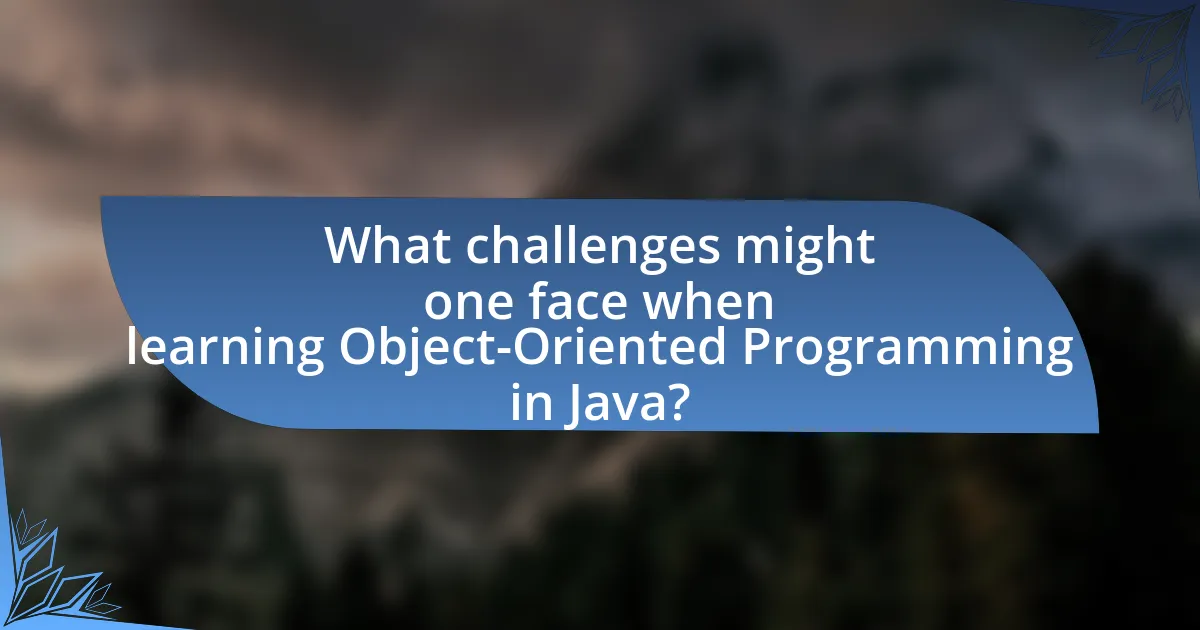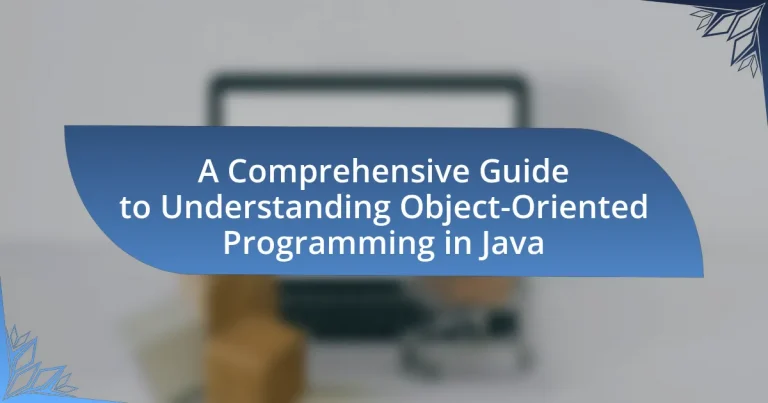Object-Oriented Programming (OOP) in Java is a programming paradigm that utilizes objects and classes to enhance software design through principles such as encapsulation, inheritance, polymorphism, and abstraction. This article provides a comprehensive guide to understanding OOP in Java, detailing its key principles, differences from other programming paradigms, and its significance in software development. It also explores the functionality of classes and objects, the role of inheritance and polymorphism, common applications across various industries, and best practices for effective implementation. Additionally, the article addresses challenges faced by beginners, misconceptions about OOP, and resources available for mastering these concepts.

What is Object-Oriented Programming in Java?
Object-Oriented Programming (OOP) in Java is a programming paradigm that uses objects and classes to structure software design. In OOP, a class defines a blueprint for creating objects, which encapsulate data and behavior. Java implements four fundamental principles of OOP: encapsulation, inheritance, polymorphism, and abstraction. Encapsulation restricts access to certain components, inheritance allows a new class to inherit properties from an existing class, polymorphism enables methods to do different things based on the object it is acting upon, and abstraction simplifies complex systems by modeling classes based on essential characteristics. These principles enhance code reusability, scalability, and maintainability, making Java a widely used language for developing robust applications.
How does Object-Oriented Programming differ from other programming paradigms?
Object-Oriented Programming (OOP) differs from other programming paradigms primarily through its use of objects to encapsulate data and behavior. In OOP, objects are instances of classes that combine state (attributes) and behavior (methods), facilitating modularity and reusability. This contrasts with procedural programming, which focuses on functions and the sequence of actions, and functional programming, which emphasizes immutability and first-class functions. OOP promotes concepts such as inheritance, polymorphism, and encapsulation, which enhance code organization and maintainability. For example, in OOP, a class can inherit properties from another class, allowing for code reuse and a hierarchical structure, which is not inherently present in procedural or functional paradigms.
What are the key principles of Object-Oriented Programming?
The key principles of Object-Oriented Programming (OOP) are encapsulation, inheritance, polymorphism, and abstraction. Encapsulation involves bundling data and methods that operate on that data within a single unit, typically a class, which restricts direct access to some of the object’s components. Inheritance allows a new class to inherit properties and behaviors from an existing class, promoting code reusability. Polymorphism enables objects to be treated as instances of their parent class, allowing for method overriding and dynamic method resolution. Abstraction simplifies complex systems by modeling classes based on essential characteristics while hiding unnecessary details. These principles are foundational in OOP, facilitating better software design and maintainability.
Why is Object-Oriented Programming important in software development?
Object-Oriented Programming (OOP) is important in software development because it enhances code reusability, scalability, and maintainability. OOP allows developers to create modular code through the use of classes and objects, which encapsulate data and behavior. This modularity facilitates easier updates and debugging, as changes in one part of the code do not necessarily affect others. According to a study by IBM, OOP can reduce development time by up to 40% due to its emphasis on reusable components. Additionally, OOP supports inheritance and polymorphism, enabling developers to build upon existing code and create more complex systems efficiently.
What are the main features of Object-Oriented Programming in Java?
The main features of Object-Oriented Programming (OOP) in Java are encapsulation, inheritance, polymorphism, and abstraction. Encapsulation allows for data hiding and restricting access to certain components, which enhances security and reduces complexity. Inheritance enables new classes to inherit properties and methods from existing classes, promoting code reusability. Polymorphism allows methods to perform differently based on the object that invokes them, facilitating flexibility in code. Abstraction simplifies complex systems by modeling classes based on essential characteristics while hiding unnecessary details. These features collectively enhance the modularity, maintainability, and scalability of Java applications.
How do classes and objects function in Java?
Classes and objects in Java function as fundamental components of object-oriented programming, where classes serve as blueprints for creating objects. A class defines properties (attributes) and behaviors (methods) that the objects instantiated from it will possess. For example, a class named “Car” may have attributes like “color” and “model,” and methods such as “drive()” and “stop()”. When an object is created from this class, it inherits these attributes and methods, allowing for the encapsulation of data and functionality. This structure promotes code reusability and modularity, as multiple objects can be created from a single class, each with its own state while sharing the same behavior.
What role do inheritance and polymorphism play in Java?
Inheritance and polymorphism are fundamental concepts in Java that enable code reusability and flexibility. Inheritance allows a class to inherit properties and methods from another class, promoting a hierarchical relationship and reducing redundancy. For example, if a class “Animal” has a method “makeSound,” a subclass “Dog” can inherit this method, allowing it to use or override it without redefining it.
Polymorphism, on the other hand, allows objects to be treated as instances of their parent class, enabling a single interface to represent different underlying forms (data types). This is exemplified through method overriding, where a subclass can provide a specific implementation of a method defined in its superclass. For instance, both “Dog” and “Cat” can override the “makeSound” method to produce different sounds, while still being referenced as “Animal” types.
Together, inheritance and polymorphism enhance the design of Java applications by facilitating easier maintenance, scalability, and the implementation of dynamic behavior, which is crucial for effective object-oriented programming.
What are the common applications of Object-Oriented Programming in Java?
Common applications of Object-Oriented Programming (OOP) in Java include software development for web applications, mobile applications, and enterprise-level applications. Java’s OOP principles, such as encapsulation, inheritance, and polymorphism, facilitate code reusability and modularity, making it ideal for building complex systems. For instance, Java is widely used in developing Android applications, where OOP allows for the creation of reusable components. Additionally, Java’s robust frameworks, like Spring and Hibernate, leverage OOP concepts to enhance application architecture and maintainability, further validating its effectiveness in various domains.
Which industries utilize Object-Oriented Programming in Java?
Object-Oriented Programming in Java is utilized across various industries, including finance, healthcare, telecommunications, and gaming. In the finance sector, Java’s OOP principles enable the development of complex trading systems and banking applications that require high reliability and security. The healthcare industry employs Java for managing patient records and healthcare applications, ensuring data integrity and scalability. Telecommunications companies use Java to build robust communication systems and network management tools, benefiting from its modularity and ease of maintenance. The gaming industry leverages Java’s OOP capabilities to create interactive and immersive gaming experiences, allowing for efficient resource management and game development.
How does Object-Oriented Programming enhance software maintainability?
Object-Oriented Programming (OOP) enhances software maintainability by promoting modularity through encapsulation, inheritance, and polymorphism. Encapsulation allows developers to bundle data and methods that operate on that data within classes, making it easier to manage and update code without affecting other parts of the system. Inheritance enables code reuse, allowing new classes to inherit properties and behaviors from existing ones, which reduces redundancy and simplifies updates. Polymorphism allows for the implementation of methods in different ways, facilitating easier changes and extensions to the codebase. These principles collectively lead to a more organized code structure, making it simpler to identify, isolate, and fix issues, ultimately improving the overall maintainability of software systems.
How can one effectively implement Object-Oriented Programming in Java?
To effectively implement Object-Oriented Programming (OOP) in Java, one should utilize its four core principles: encapsulation, inheritance, polymorphism, and abstraction. Encapsulation involves bundling data and methods that operate on that data within classes, which enhances data protection and modularity. Inheritance allows a new class to inherit properties and behaviors from an existing class, promoting code reusability. Polymorphism enables methods to perform differently based on the object that invokes them, facilitating flexibility in code. Abstraction simplifies complex systems by exposing only the necessary parts while hiding the implementation details. These principles are foundational in Java, as evidenced by its class-based structure and support for interfaces, which further reinforce OOP concepts.
What are best practices for designing classes in Java?
Best practices for designing classes in Java include following principles such as encapsulation, single responsibility, and proper naming conventions. Encapsulation ensures that class attributes are private and accessed through public methods, promoting data hiding and integrity. The single responsibility principle states that a class should have only one reason to change, which simplifies maintenance and enhances clarity. Additionally, using meaningful and descriptive names for classes and methods improves code readability and understanding. These practices are supported by the object-oriented design principles outlined in the SOLID framework, which emphasizes the importance of creating robust and maintainable code structures.
How can encapsulation be effectively utilized in Java?
Encapsulation can be effectively utilized in Java by using access modifiers to restrict access to class members, thereby protecting the internal state of an object. This is achieved through the use of private variables and public getter and setter methods, which control how the data is accessed and modified. For example, a class can have private fields that are only accessible through public methods, ensuring that any changes to the fields are validated or processed appropriately. This practice not only enhances data security but also promotes a clear separation between an object’s interface and its implementation, which is a fundamental principle of object-oriented programming.

What challenges might one face when learning Object-Oriented Programming in Java?
Learning Object-Oriented Programming (OOP) in Java presents several challenges, including grasping core concepts such as inheritance, polymorphism, encapsulation, and abstraction. These concepts can be abstract and difficult to visualize, leading to confusion for beginners. Additionally, understanding the syntax and structure of Java, which is strict compared to other programming languages, can pose a barrier to entry.
Moreover, the transition from procedural programming to OOP requires a shift in thinking, as learners must adapt to designing systems around objects rather than functions. This paradigm shift can be overwhelming, particularly for those without prior programming experience.
Furthermore, debugging OOP code can be complex due to the interdependencies between objects, making it harder to trace errors. According to a study published in the Journal of Computer Science Education, many students struggle with these concepts, indicating that a significant percentage of learners find OOP challenging to master.
What common misconceptions exist about Object-Oriented Programming?
Common misconceptions about Object-Oriented Programming (OOP) include the belief that it is synonymous with code reuse, that it inherently leads to better performance, and that it guarantees software quality. While OOP promotes code reuse through inheritance and polymorphism, it does not ensure that reused code is efficient or appropriate for every context. Additionally, OOP can introduce overhead that may negatively impact performance, particularly in scenarios where simpler programming paradigms would suffice. Lastly, the assumption that OOP automatically results in higher software quality is misleading; quality depends on various factors, including design principles and developer expertise, rather than the mere use of OOP concepts.
How can beginners overcome the learning curve associated with Object-Oriented Programming?
Beginners can overcome the learning curve associated with Object-Oriented Programming (OOP) by engaging in hands-on practice, utilizing online resources, and breaking down complex concepts into manageable parts. Engaging in hands-on practice allows beginners to apply theoretical knowledge in real coding scenarios, reinforcing their understanding. Online resources, such as tutorials and coding platforms, provide structured learning paths and community support, which can enhance comprehension. Breaking down complex concepts, such as classes, objects, inheritance, and polymorphism, into simpler components makes them easier to grasp. Research indicates that active learning strategies, including coding exercises and peer discussions, significantly improve programming skills and retention of OOP principles.
What resources are available for mastering Object-Oriented Programming in Java?
To master Object-Oriented Programming in Java, several resources are available, including online courses, textbooks, and documentation. Online platforms like Coursera and Udemy offer structured courses that cover OOP principles in Java, often featuring hands-on projects. Textbooks such as “Effective Java” by Joshua Bloch provide in-depth insights into best practices and design patterns in Java. Additionally, the official Java documentation from Oracle serves as a comprehensive reference for understanding Java’s OOP features, including classes, inheritance, and polymorphism. These resources collectively equip learners with the necessary knowledge and skills to excel in Object-Oriented Programming using Java.
Which online courses are highly recommended for learning Java OOP?
Highly recommended online courses for learning Java OOP include “Java Programming and Software Engineering Fundamentals” by Duke University on Coursera, “Java Object-Oriented Programming” by the University of California, San Diego on edX, and “Mastering Java OOP” on Udemy. These courses provide comprehensive coverage of object-oriented programming concepts in Java, including encapsulation, inheritance, and polymorphism, which are essential for mastering the language. The courses are well-structured, often include hands-on projects, and have received positive reviews from learners, confirming their effectiveness in teaching Java OOP principles.
What books provide in-depth knowledge of Object-Oriented Programming in Java?
Books that provide in-depth knowledge of Object-Oriented Programming in Java include “Effective Java” by Joshua Bloch, which offers best practices and design patterns for Java programming. Another essential book is “Java: The Complete Reference” by Herbert Schildt, which covers fundamental concepts and advanced features of Java, including OOP principles. Additionally, “Head First Java” by Kathy Sierra and Bert Bates presents OOP concepts in an engaging and accessible manner, making it suitable for beginners. These books are widely recognized in the programming community for their comprehensive coverage of Object-Oriented Programming in Java.

How can one troubleshoot issues in Object-Oriented Programming in Java?
To troubleshoot issues in Object-Oriented Programming in Java, one should systematically identify and isolate the problem by using debugging tools, reviewing error messages, and examining the code structure. Debugging tools like Eclipse or IntelliJ IDEA provide features such as breakpoints and step execution, which help in tracking down the source of errors. Additionally, reviewing stack traces can reveal the exact location of exceptions, while analyzing class hierarchies and relationships can uncover design flaws. According to a study by the University of California, effective debugging practices can reduce the time spent on fixing issues by up to 30%, demonstrating the importance of a structured approach in troubleshooting.
What are common errors encountered in Java OOP?
Common errors encountered in Java OOP include improper use of inheritance, incorrect encapsulation, and misuse of polymorphism. Improper inheritance can lead to issues such as the diamond problem, where a class inherits from two classes that have a common ancestor, causing ambiguity. Incorrect encapsulation occurs when class members are not adequately protected, leading to unintended access and modification of data. Misuse of polymorphism often results in runtime errors when method overriding is not implemented correctly, causing unexpected behavior. These errors can significantly impact code maintainability and functionality, highlighting the importance of adhering to OOP principles in Java.
How can debugging techniques be applied to Object-Oriented Programming in Java?
Debugging techniques can be effectively applied to Object-Oriented Programming (OOP) in Java by utilizing tools and methodologies that focus on class structures, object states, and method interactions. For instance, using integrated development environments (IDEs) like Eclipse or IntelliJ IDEA allows developers to set breakpoints, inspect variables, and step through code execution, which is crucial for understanding how objects interact and where errors may arise. Additionally, employing logging frameworks such as Log4j or SLF4J enables developers to track the flow of execution and capture the state of objects at various points, facilitating the identification of logical errors. Furthermore, unit testing frameworks like JUnit can be used to isolate and test individual classes and methods, ensuring that each component behaves as expected, which is essential in OOP where encapsulation and modularity are key principles. These techniques collectively enhance the debugging process in Java OOP by providing clear insights into the behavior of objects and their interactions.
What practical tips can enhance your Object-Oriented Programming skills in Java?
To enhance Object-Oriented Programming skills in Java, practice implementing design patterns such as Singleton, Factory, and Observer. These patterns provide proven solutions to common problems, improving code organization and reusability. Additionally, regularly refactoring code to adhere to the SOLID principles—Single Responsibility, Open/Closed, Liskov Substitution, Interface Segregation, and Dependency Inversion—ensures better maintainability and scalability. Engaging in code reviews and collaborating with peers can also provide valuable feedback and alternative perspectives, further solidifying understanding and application of OOP concepts in Java.
How can collaboration and code reviews improve your understanding of Java OOP?
Collaboration and code reviews enhance understanding of Java OOP by facilitating knowledge sharing and exposing developers to diverse coding practices. When working with others, developers encounter different perspectives on object-oriented design principles, such as encapsulation, inheritance, and polymorphism. This exposure helps solidify their grasp of these concepts.
Moreover, code reviews provide constructive feedback, allowing developers to identify and rectify misconceptions about OOP principles in their code. Research indicates that peer review processes can lead to a 30% reduction in defects, which underscores the effectiveness of collaborative learning in improving coding skills and understanding of complex topics like Java OOP.
What role does practice play in mastering Object-Oriented Programming in Java?
Practice is essential for mastering Object-Oriented Programming (OOP) in Java, as it enables learners to apply theoretical concepts in real-world scenarios. Engaging in consistent coding exercises helps reinforce understanding of key OOP principles such as encapsulation, inheritance, and polymorphism. Research indicates that hands-on experience significantly enhances retention and problem-solving skills, with studies showing that learners who practice coding regularly outperform those who do not. For instance, a study by the National Academy of Sciences found that active engagement in programming tasks leads to deeper cognitive processing, which is crucial for mastering complex programming paradigms like OOP.


